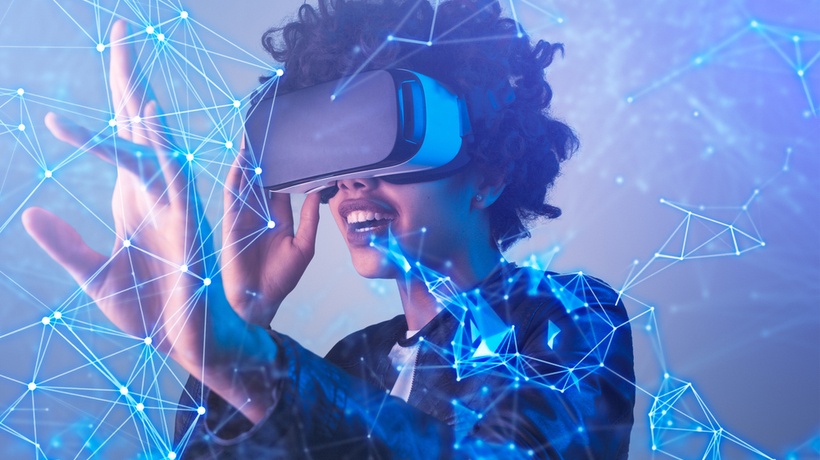Image: https://elearningindustry.com/microlearning-training-content-101
Introduction:
In today's rapidly changing business landscape, organizations are constantly seeking new and effective ways to enhance employee skills and knowledge. Human Resource Management (HRM) plays a pivotal role in this process, with training and development programs being critical for employee growth and organizational success. As technology continues to evolve, HRM is also embracing innovative approaches to training and development to meet the changing needs of modern employees. In this blog article, we will explore the latest trends and innovations in HRM training and development, including micro-learning, gamification, virtual and augmented reality, and other emerging technologies, with references and citations to support our findings.
Micro-learning: Bite-sized Learning for Maximum Impact
Image: https://www.rbl.net/case-studies/microlearning-leadership-development-program
Micro-learning has gained significant popularity in recent years as a way to deliver training content in short, easily digestible chunks. It involves breaking down complex information into smaller, focused modules that employees can consume at their own pace. Micro-learning allows employees to access training materials on demand, making it flexible and convenient for busy schedules. According to research by the Association for Talent Development (ATD), micro-learning can result in a 17% increase in knowledge retention compared to traditional training methods (ATD, 2019). Organizations can leverage micro-learning through various formats, such as videos, infographics, quizzes, and interactive modules, to provide engaging and effective training experiences.
Gamification: Making Learning Fun and Engaging
Image: https://www.dqindia.com/gamification-making-education-engaging-immersive-fun/
Gamification is the use of game elements in non-gaming contexts, such as training and development, to enhance engagement and motivation. It involves incorporating elements like points, badges, leader boards, and rewards into training programs to create a sense of competition and challenge. Gamification can make learning fun and enjoyable, increasing employee motivation and participation. Research by the eLearning Industry indicates that gamified training can improve employee engagement by up to 60% (Industry, 2019). Organizations can implement gamification in various training initiatives, such as onboarding, compliance training, and skills development, to boost employee participation and knowledge retention.
Virtual and Augmented Reality: Immersive Learning Experiences
Image: https://elearningindustry.com/immersive-learning-future-of-elearning
Virtual and augmented reality (VR/AR) technologies are transforming the landscape of employee training by providing immersive and realistic learning experiences. VR involves creating a simulated environment that allows employees to practice skills and scenarios in a safe and controlled environment, while AR overlays digital content onto the real-world environment. These technologies can be particularly effective in training for high-stakes situations, such as safety protocols, customer interactions, or complex procedures. According to a study by PwC, VR/AR training can lead to a 31% improvement in employee performance (PwC, 2019). Organizations can leverage VR/AR in various training programs, such as simulations, role-plays, and interactive scenarios, to enhance employee skills and knowledge retention.
Adaptive Learning: Personalized Training for Individual Needs
Image: https://elearningindustry.com/strenghts-weaknesses-adaptive-learning-paths-case-study
Adaptive learning is an approach that tailors training content and delivery based on individual learner needs and preferences. It uses data and analytics to understand the strengths and weaknesses of employees and dynamically adjusts the training content and pace to meet their unique requirements. Adaptive learning can help employees learn at their own pace, fill gaps in their knowledge, and focus on areas that need improvement. According to a report by Docebo, adaptive learning can result in a 50% increase in content retention and a 45% decrease in training time (Docebo, 2020). Organizations can implement adaptive learning through learning management systems (LMS) and advanced analytics to provide personalized and effective training experiences for their employees.
Social and Collaborative Learning: Learning from Each Other
Image: https://csantaanaenglish.wordpress.com/2016/12/09/do-you-use-cooperative-learning-in-your-classroom/
Social and collaborative learning involve leveraging the power of social interactions and collaboration among employees to facilitate learning. It encourages employees to learn from each other through peer-to-peer discussions, knowledge sharing, and collaborative projects. Social and collaborative learning can foster a culture of continuous learning, where employees learn not only from formal training programs but also from their colleagues and networks. Research by Deloitte indicates that social and collaborative learning can improve employee performance by up to 75% (Deloitte, 2019 ). Organizations can promote social and collaborative learning through online communities, discussion forums, team-based projects, and mentoring programs to facilitate knowledge sharing and peer learning among employees.
Video: https://youtu.be/6zoaxSR2IE4
Disadvantages of Current Trends in Training & Development
While current trends in HRM training and development offer many advantages, such as increased engagement, personalized learning, and improved performance, there are also some potential disadvantages that organizations should be aware of. These may include:
1. Overreliance on technology: As organizations embrace emerging technologies like micro-learning, gamification, virtual and augmented reality, and adaptive learning, there may be a risk of overreliance on technology and neglecting the human element in training and development (Boudreau, 2007). It's important to strike a balance between technology and human interaction to ensure effective learning experiences.
2. Cost and resource implications: Implementing and maintaining new training and development trends may require significant investments in technology, infrastructure, and resources (Group, 2019 ). Organizations need to carefully consider the cost implications and weigh them against the potential benefits to ensure that the investment is justified.
3. Learning preferences and accessibility: Not all employees may prefer or have access to the latest training and development trends. For example, some employees may have limited access to technology or prefer traditional methods of learning (Guo, 2008). Organizations should consider the diverse learning preferences and accessibility needs of their workforce when implementing new trends to ensure inclusivity and effectiveness.
4. Learning effectiveness and measurement: While the latest trends in HRM training and development may offer engaging and interactive learning experiences, it may be challenging to measure their effectiveness and impact on performance (Lei, 2018). Organizations should establish appropriate metrics and evaluation methods to assess the outcomes and ROI of these new approaches.
5. Rapidly changing technology landscape: Technology is constantly evolving, and the latest trends in HRM training and development may become obsolete or replaced by newer approaches in a short period of time (Tung, 2015). Organizations need to stay updated with the rapidly changing technology landscape and be agile in adapting their training and development strategies accordingly.
It's essential for organizations to carefully evaluate the potential disadvantages of current trends in HRM training and development and develop strategies to mitigate them to ensure that the overall training and development efforts are effective, inclusive, and aligned with the needs of their workforce.
Conclusion:
As HRM continues to evolve, training and development are embracing innovative approaches to meet the changing needs of employees. Micro-learning, gamification, virtual and augmented reality, adaptive learning, and social and collaborative learning are some of the latest trends and innovations in HRM training and development that are transforming the landscape of employee learning. These approaches provide organizations with opportunities to deliver engaging, effective, and personalized training experiences that align with the preferences and requirements of modern employees. By leveraging these trends, organizations can unlock the future of employee learning and development, driving improved performance, and organizational success.
References
ATD, A. f. T. D., 2019. Microlearning: Delivering Bite-Sized Knowledge When and Where It's Needed. https://www.td.org/insights/microlearning-delivering-bite-sized-knowledge-when-and-where-its-needed.
Boudreau, J. W. &. R. P. M., 2007. Beyond HR: The new science of human capital.
Deloitte, 2019 . Social Learning: Empower Employees Through Knowledge Sharing. https://www2.deloitte.com/us/en/insights/focus/human-capital-trends/2019/social-learning-empower-employees-through-knowledge-sharing.html.
Docebo, 2020. The 2020 Learning & Development Trends: Workplace Learning Report. https://www.docebo.com/learning-technology-resources/2020-learning-and-development-trends/, s.l.: s.n.
Group, B. H., 2019 . Learning technology trends survey: Spotlight on augmented and virtual reality. https://www.brandonhall.com/wp-content/uploads/2019/06/2019-Augmented-and-Virtual-Reality-Research-Report.pdf.
Guo, R. D. T. &. P. S., 2008. Digital natives, digital immigrants: An analysis of age and ICT competency in teacher education. pp. 38(3), 235-254..
Industry, e., 2019. 7 Must-Know Gamification Benefits in Corporate Training. https://elearningindustry.com/7-gamification-benefits-in-corporate-training.
Lei, J. &. Z. Y., 2018. Adaptive learning: A review and analysis of its impact on pedagogy and student learning.. pp. 21(2), 222-238..
PwC, 2019. Virtual Reality & Augmented Reality in Training: Future Workforce. https://www.pwc.com/us/en/industries/technology/library/virtual-reality-augmented-reality-in-training.html.
Tung, F. &. C. S., 2015. The effects of technology-embedded learning environment on learner’s engagement and achievement in Taiwanese primary classrooms. pp. 18(4), 158-171.







Timely discussion Prasad. Current trends in HRM training and development are centered around unlocking the future of employee learning through innovative approaches. Organisations are now focusing on utilising technology, incorporating personalised and adaptive learning methods, and emphasising continuous learning to meet the evolving needs of the workforce (Ngo et al., 2018). For instance, online platforms, virtual reality, and gamification are being used to create interactive and engaging learning experiences (Bauer et al., 2018). Additionally, personalised and adaptive learning approaches, such as microlearning and just-in-time training, are gaining popularity as they allow employees to learn at their own pace and access relevant content when needed (Stredwick, 2020). Furthermore, organisations are recognising the importance of continuous learning as a means to enhance skills and competencies, foster innovation, and drive employee engagement and retention (Docebo, 2019). These innovative approaches to HRM training and development are transforming the way organisations approach employee learning and development in the modern workplace (Ngo et al., 2018).
ReplyDeleteThank you Lasni for sharing your insights on the current trends in HRM training and development, and how organisations are leveraging technology and innovative approaches to meet the evolving needs of the workforce. I completely agree that personalised and adaptive learning methods, just-in-time training, and continuous learning are gaining traction in the industry. It's exciting to see how these approaches can drive employee engagement and retention while fostering innovation and enhancing skills and competencies.
DeleteAs a reader, I found this article helpful and informative in learning about the current HRM training and development trends. The author provides good examples of how organisations can improve employee skills and knowledge by utilising micro-learning, gamification, virtual and augmented reality, adaptive learning, and social and collaborative learning.
ReplyDeleteAre there any drawbacks to these innovative training methods that organisations should be aware of, and how can these risks be mitigated?
Hi Niluka, Thank you for your positive feedback on the article. According to Bauer et al. (2018), organisations are now utilising innovative approaches, such as online platforms, virtual reality, and gamification, to create interactive and engaging learning experiences. Additionally, personalised and adaptive learning approaches, such as microlearning and just-in-time training, are gaining popularity as they allow employees to learn at their own pace and access relevant content when needed (Stredwick, 2020). Furthermore, continuous learning is recognised as a means to enhance skills and competencies, foster innovation, and drive employee engagement and retention (Docebo, 2019).
DeleteHowever, there are some potential drawbacks to these innovative training methods that organisations should be aware of. For instance, virtual and augmented reality training programs require a significant investment in technology, and not all organisations may have the necessary resources (Bauer et al., 2018). Similarly, social and collaborative learning methods may require significant coordination and facilitation to ensure that all participants are engaged and learning effectively (Stredwick, 2020).
To mitigate these risks, organisations should carefully assess the costs and benefits of these training methods before implementing them. Additionally, training programs should be designed to meet the specific needs of the organisation and the target audience, and appropriate resources should be allocated to ensure their effectiveness (Docebo, 2019).
Interestingly discussed.
ReplyDeleteMicrolearning, VR and AR technology, Gamification reflect the changing needs and expectations of the workforce, as well as the advancements in technology and learning science. In addition, blended learning is also available which combines multiple training methods, such as classroom instruction, e-learning, and on-the-job training, to create a comprehensive and flexible training program. (Wittman, M. (2021). By adopting these trends, organizations can improve the effectiveness and efficiency of their training and development programs, and ultimately enhance their overall performance and competitiveness.
Thank you for your comment Kabilashini. I completely agree with your points on how microlearning, VR and AR technology, gamification, and blended learning are transforming the field of training and development. As noted by Wittman (2021), blended learning provides the opportunity to combine different training methods to create a tailored and effective training program that caters to the specific needs of the workforce. By adopting these innovative approaches, organisations can improve employee engagement, productivity, and retention, leading to better organisational performance and competitiveness.
DeleteI want to point out that the ideas you have discussed in the section titled "Current trends in hrm training and development" are really intriguing and crucial for a company. In addition, I believe that by applying the ideas you expressed in practice within a business, the success of the organization can be increased.
ReplyDeleteThank you Sineth for your feedback on the importance of applying current trends in HRM training and development within a business. Indeed, implementing these ideas in practice can lead to significant improvements in employee learning and development, ultimately enhancing the overall performance of the organization. It is essential for companies to continually evolve and adapt to changing workforce needs and technological advancements to remain competitive in today's dynamic business environment.
Delete